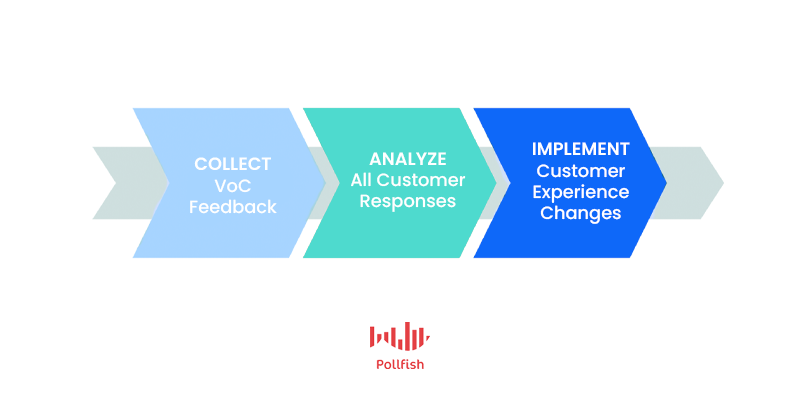How to Use Surveys to Bolster the Voice of Customer (VoC)

Voice of the Customer, or VoC, is a term used to describe customer feedback. VoC has made waves in the customer experience (CX) space and is considered a core business strategy.
This is largely due to VoC programs’ (such as VoC surveys) contribution to improving customer satisfaction. Happy customers won’t just purchase from a brand once; rather they are likely to become loyal to it, which entails making repeat purchases.
The PWC has found that 43% of customers are willing to pay more for a good customer experience. Consequently, a bad customer experience will drive customers and potential customers away from a business.
This article will explain the Voice of Customer in-depth so that you can implement an effective VoC program.
Defining the Voice of Customer
While VoC falls under the specialty of customer feedback, it denotes so much more. Voice of Customer is a research method businesses use to discover the needs, complaints and general commentary of their customers.
It isn’t merely a single touchpoint, such as a conversation with a salesperson, as it constitutes a process. The VoC process includes various programs that work to capture all that customers have to say about a brand, product, service or experience.
It consolidates all of this feedback into a general customer perspective of a brand. Brands can then use this perspective to bridge the gap between customer expectations and business practices.
In short, VoC allows brands to fully understand their customers’ specific grievances and likings of a brand, along with their overall views of it.
Voice of the Customer Applications
VoC programs have a wide scope of utility. That is why you can tinker your VoC outlet to gather specific information around your business. The following lists some of the most crucial applications VoC can help execute.
- Informing the design specifications of a new product.
- Improving the functionality of a product or product feature.
- Gaining access to the sentiment around interactions with representatives and other employees.
- Finding product, service or experience features that are excelling or poorly performing.
- Identifying glitches in the UX of a product or digital experience.
- Spotting early warnings of a potential brand crisis.
- Creating solutions to improve customer experience.
- Performing market research about your customers and site visitors.
- Avoiding past mistakes and underperforming experiences.
- Increasing customer retention.
Voice of the Customer Examples
As aforementioned, Voice of Customer does not entail only one touchpoint, i.e., the VoC program. Rather, it works via a multi-program approach. The best way to fully acquire and retain your customers’ desires and opinions is by deploying several of them in your process.
The following enumerates key VoC programs for obtaining a sharp sense of your customers in relation to your company.
- Customer Interviews: One of the more traditional VoC programs, these interviews are usually conducted over the phone. A traditional interview requires a company representative to call the customer and inquire about products, services, a recent transaction, a recent customer support interaction or anything else related to company/customer relations.
- Can be done in-person, over the phone, via email.
- Known as the most personal interaction.
- Costliest to conduct.
- VoC Surveys: Surveys allow you to collect customer feedback via customer satisfaction surveys. Luckily, there are several survey types that fall under this category such as the Net Promoter Score (NPS), Customer Satisfaction Score (CSAT), Customer Effort Score (CES) and other such surveys.
- Most are conducted online, either on-site or via email prompts.
- Most effective when deployed on-site or in-app to collect real-time users.
- Most scalable program.

- Social Listening: As its name hints at, social listening involves using social media platforms for collecting VoC data. This method allows brands to find, scrutinize, and respond to conversations about them on these platforms. This technique goes beyond tracking reviews on social media, rather it involves gathering real conversations surrounding your business, its offering and associations.
- Can also include online forums, blog comments, and product review sites.
- Great to track for natural commentary about your brand.
- Allows you to respond to customer concerns and assure them their feedback is valued.
- Live Chat: Live chat allows you to speak with customers 1:1, much like you would on the phone, except it is more in line with their real-time issues, ex: trouble at site checkout.
- Allows you to help consumers as they navigate your site or to address problems or questions about your products/service.
- Provides a way to reduce customer dissatisfaction.
- Enables you to gain more insights by sending the customer a follow-up survey.
- Website Behaviors: Studying website behaviors will allow you to detect any site glitches or issues hampering your customers digital UX.
- Shows you how users traverse and interact with your website.
- Can be studied via digital experience analytics platforms.
- Can be compiled via session replay tools.
The Voice of Customer Process
Since VoC relies on more than just one touchpoint, it also entails much more than just the touchpoint, i.e., the program itself. It calls for other actions, as it is a process.
The VoC process will differ from brand to brand depending on the number of VoC techniques you deploy, the timeframe you set to review them and their relation to other campaigns (advertising, branding, etc).
The following steps present a general overview of the main undertakings in a VoC process.

- Collect your data with the programs mentioned above, such as voice of customer surveys, etc.
- Analyze all of your responses across program types. Search for commonalities in complaints, inquiries, points of friction, expectations and other customer concerns. Use these to determine what to prioritize first. You should pay attention to the severity of an issue, along with its frequency.
- Implement any necessary changes to improve customer experience and satisfaction. Make sure to respond to customers who have contacted your business in a way that shows you recognize their concerns and appreciate their feedback. Assure them that their voices are heard and that your brand will take the necessary steps to correct any issue or improve its product, service or experience.
Questions to Use When Collecting VoC Feedback
VoC represents feedback that the customers may have initiated themselves, i.e., when they go to your website and use the live chat, or when they call in to express their opinions with a product or service.
This means that much of the VoC responses you’ll receive are pure commentary, that is, the feedback given directly and not in response to your brand’s questions. However, you can still gather VoC data by asking the questions yourself in your VoC programs.
The following lists question examples to use in your VoC methods. These will help you gather thoughts on various customer/company matters, such as company reputation and brand loyalty.
- What comes to mind when you think about [company/product name]?
- Best Methods: VoC surveys, phone, in-person interview
- What features do you look for in a company or product?
- Best Methods: VoC surveys, phone, in-person interview
- How can [company] improve your customer experience?
- Best Methods: VoC surveys, phone, in-person interview, dedicated feedback forms, social media
- What company and/or product would you recommend to a friend and why?
- Best Methods: VoC surveys, phone, in-person interview
- What is a product/service you prefer over ours and explain why?
- Best Methods: VoC surveys, live chat, dedicated feedback forms
- What were the main issues you had when using our website?
- Best Methods: Live chat, phone calls, VoC surveys
- On a scale of 1-7, how would you rate your interaction with our sales representative?
- VoC surveys, dedicated feedback forms
- The surveys would use Likert scale or semantic differential questions
Taking Your VoC to the Next Level
In summary, brands can record their Voice of the Customer data through a variety of means, including focus groups, emails and even offsite surveys. VoC surveys that can be deployed across websites and apps are the best VoC program environment, as it grants you the ability to collect feedback in real-time and in a timely manner.
The point of the entire process is to learn how to best engage and retain your target market.
A poor customer experience will induce more bounces, fewer purchases and worst of all, the loss of a customer.
Contrarily, a satisfying customer experience will foster customer retention, gaining you a steady stream of repeat purchases and brand loyalty.
Frequently asked questions
What is the Voice of Customer?
The Voice of Customer (or VoC) is a term that is used to describe customer feedback and the programs used to deliver such feedback. It is a research method that is used to better understand the needs, feelings, and complaints of existing customers.
Why are VoC programs important to a business?
VoC programs can improve the overall customer experience, which can result in an increase in overall customer satisfaction, retention, and referral levels.
What methods can be used to gather Voice of Customer feedback?
In order to gain a broader understanding of VoC, businesses often use several methodologies to collect feedback from customers including interviews, surveys, social listening, live chat, reviews, phone support and website user testing.
What are some examples of VoC surveys?
The Net Promoter Score survey (NPS), Customer Satisfaction Score (CSAT), Customer Effort Score (CES) are good examples of VoC surveys.
What is the VoC process for improving the customer experience?
The VoC process is conducted by first collecting data from existing customers, and then analyzing the responses to identify correlations between data. Based on the conclusions of data analysis, changes are implemented in order to improve the overall customer experience.
Pollfish Marketing Team
Ready to Try Pollfish?
Create your survey with AI, target high-quality respondents starting at $0.95 per complete, and start getting results in just minutes in real-time. From running a simple product concept survey to managing a constant stream of trackers for dozens of clients in dozens of countries, we’ve got you.

